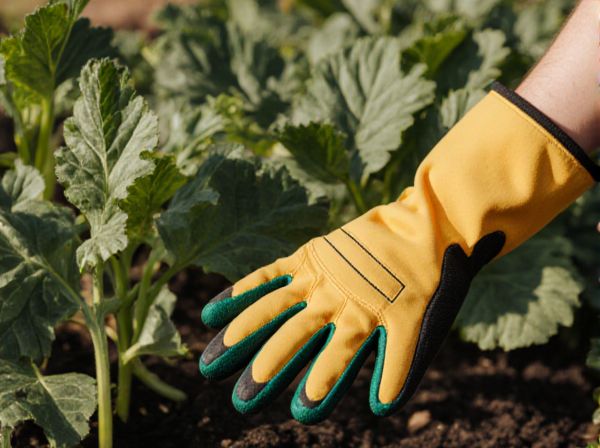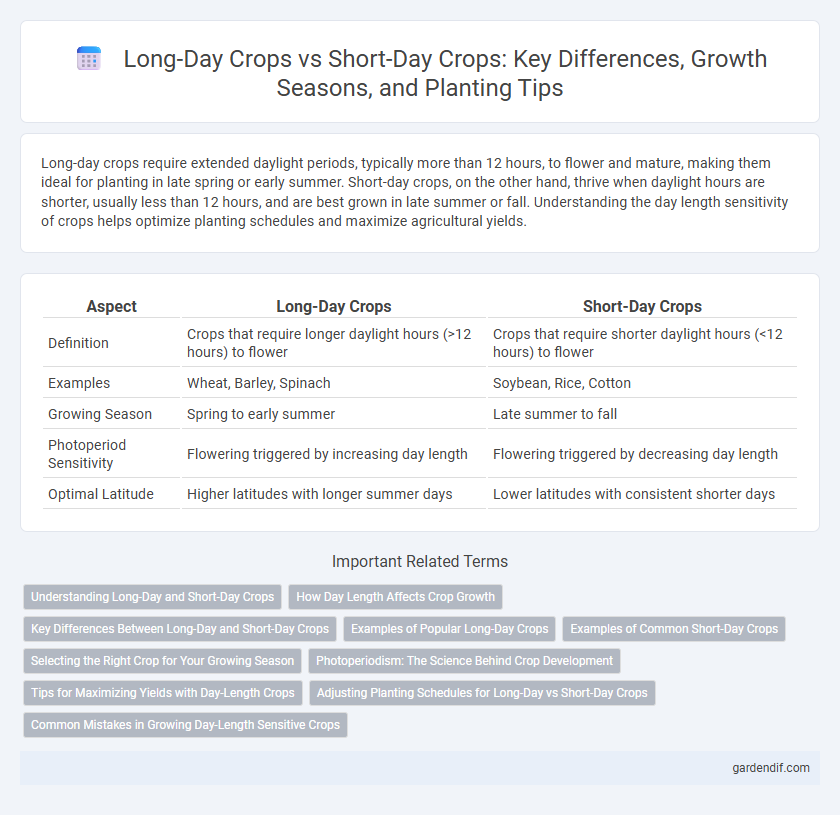
Long-day crops vs Short-day crops Illustration
Long-day crops require extended daylight periods, typically more than 12 hours, to flower and mature, making them ideal for planting in late spring or early summer. Short-day crops, on the other hand, thrive when daylight hours are shorter, usually less than 12 hours, and are best grown in late summer or fall. Understanding the day length sensitivity of crops helps optimize planting schedules and maximize agricultural yields.
Table of Comparison
| Aspect | Long-Day Crops | Short-Day Crops |
|---|---|---|
| Definition | Crops that require longer daylight hours (>12 hours) to flower | Crops that require shorter daylight hours (<12 hours) to flower |
| Examples | Wheat, Barley, Spinach | Soybean, Rice, Cotton |
| Growing Season | Spring to early summer | Late summer to fall |
| Photoperiod Sensitivity | Flowering triggered by increasing day length | Flowering triggered by decreasing day length |
| Optimal Latitude | Higher latitudes with longer summer days | Lower latitudes with consistent shorter days |
Understanding Long-Day and Short-Day Crops
Long-day crops, such as wheat and barley, require more than 12 hours of daylight to trigger flowering, thriving in extended daylight conditions typical of late spring or early summer. Short-day crops, including soybeans and rice, initiate flowering when daylight drops below 12 hours, adapting to shorter daylight periods found in late summer or early autumn. Understanding the photoperiod responses of these crops is essential for optimizing planting schedules and maximizing agricultural yield in varying seasonal conditions.
How Day Length Affects Crop Growth
Long-day crops such as wheat, barley, and spinach require extended daylight periods exceeding 12 hours to initiate flowering and achieve optimal growth. In contrast, short-day crops like rice, soybeans, and maize flower when daylight falls below a critical threshold, typically around 12 hours. The photoperiod sensitivity of these plants regulates their developmental stages, directly influencing yield, maturation time, and planting schedules based on seasonal day length variations.
Key Differences Between Long-Day and Short-Day Crops
Long-day crops, such as wheat and spinach, require longer daylight hours, typically more than 12 hours, to initiate flowering and reach maturity, while short-day crops like rice and soybean bloom when daylight is shorter than 12 hours. The photoperiod sensitivity of these crops dictates their optimal planting seasons; long-day crops thrive in late spring or early summer, whereas short-day crops perform best in late summer or early fall. Understanding the key differences in light exposure requirements is crucial for maximizing crop yield and aligning agricultural practices with seasonal changes.
Examples of Popular Long-Day Crops
Popular long-day crops include wheat, barley, oats, and rye, which require extended daylight hours to initiate flowering and boost grain production. These crops thrive in temperate regions where the growing season has long daylight periods, typically in late spring and early summer. Understanding the photoperiod sensitivity of long-day crops is crucial for optimizing planting schedules and maximizing yield.
Examples of Common Short-Day Crops
Common short-day crops include rice, soybeans, and cotton, which require nights longer than a critical length to trigger flowering. These plants typically flower during late summer or fall when day length decreases, ensuring optimal growth and yield. Short-day crops are essential in tropical and subtropical regions due to their sensitivity to photoperiod changes.
Selecting the Right Crop for Your Growing Season
Selecting the right crop for your growing season depends primarily on day length sensitivity; long-day crops like wheat, barley, and spinach thrive when daylight exceeds 12 hours, promoting flowering and growth. Short-day crops such as soybeans, rice, and tobacco require shorter daylight periods, typically less than 12 hours, to trigger flowering and maximize yield. Understanding the photoperiodic requirements of these crops ensures optimal planting times and improves harvest success in varying seasonal conditions.
Photoperiodism: The Science Behind Crop Development
Photoperiodism regulates the flowering and growth cycles of long-day and short-day crops by responding to the length of daylight exposure. Long-day crops like wheat and barley require extended daylight periods to initiate flowering, while short-day crops such as soybeans and rice flower when daylight is shorter. This adaptive mechanism ensures optimal crop development and yield by synchronizing growth with seasonal changes in day length.
Tips for Maximizing Yields with Day-Length Crops
Long-day crops such as wheat, barley, and spinach thrive when exposed to extended daylight, typically exceeding 14 hours, promoting robust vegetative growth and higher yields. Short-day crops like rice, soybeans, and chrysanthemums require fewer daylight hours, often under 12 hours, to trigger flowering and maximize fruit or seed production. Adjusting planting dates to align with the natural photoperiod, utilizing supplemental lighting for long-day crops, and selecting crop varieties adapted to local day lengths are essential strategies for optimizing crop yield in both long-day and short-day species.
Adjusting Planting Schedules for Long-Day vs Short-Day Crops
Long-day crops, such as wheat and barley, require extended daylight periods exceeding 14 hours to trigger flowering, making early spring or late winter planting essential for optimal yield. Short-day crops like rice and soybean initiate flowering when daylight falls below 12 hours, necessitating planting during late summer or early fall to align growth stages with shorter days. Adjusting planting schedules based on photoperiod sensitivity ensures synchronization with seasonal daylight patterns, maximizing crop productivity and minimizing growth stress.
Common Mistakes in Growing Day-Length Sensitive Crops
Growing long-day crops during short-day seasons or short-day crops during long-day seasons often results in poor flowering and reduced yields. Common mistakes include failing to recognize crop-specific photoperiod requirements and ignoring environmental cues such as light duration and intensity. Farmers should closely monitor day length and select appropriate varieties to optimize growth and maximize productivity.
Long-day crops vs Short-day crops Infographic

 gardendif.com
gardendif.com